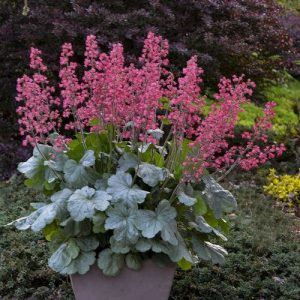“Indoors or out, no one relaxes in March,
that month of wind and taxes.
The wind will presently disappear,
the taxes last us all the year.”
– Ogden Nash
March is a month of ever-changing weather systems. Beginning with the fateful ides (to Julius Caesar, anyway) on the 15th, to St. Patrick’s Day on the 17th, to Earth day on the 20th, it is still winter, even though there may be spring-like days. The 20th of March is the official beginning of spring—usually ushered in on a blanket of snow up here in the Sierra.
One day we can be snowed in and freezing, and the next day it can be 60 degrees and almost balmy. Winter won’t be over until after mid-March, so bear that in mind when you make up a “to do” list for your garden. If you live above 3,500 feet, you are probably safe throwing another log on the fire and ignoring the garden altogether for another month.
Lower down the mountain, though, this is the time to plant seed for frost-tolerant perennials. Columbine, heuchera and delphinium are good choices for this changeover season. Sow the seed for cool season grasses, such as tall fescue. This is the last month for planting bare root and deciduous trees and shrubs.
Below 2,000 feet you are pretty safe planting Canterbury bells (campanula), pansies, primula and geraniums. If you are interested in ground cover, try rosemary and manzanita, as they are drought tolerant and the rosemary is fragrant. In shady areas, plant campanula, Liriope muscari (“big blue” lilyturf), scented geraniums, viola, dianthus, Scabiosa caucasica (pincushion flower), and creeping thyme.
In areas of the garden that get plenty of sun try planting Acorus gramineus ‘Ogon’ (sweet flag), Artemesia (native sage), Baccharris (coyote brush), creeping phlox (subulata), dwarf dianthus, rosemary, Scabiosa caucasica and creeping thyme. If you have a shady area in your garden that is also dry, Pacific Coast Hybrid Iris is a good choice.
Most established trees and shrubs don’t need fertilizer unless the leaves look pale or lack vigor. This is the time to fertilize fall-planted annuals and perennials, as well as roses. Use dormant oil on roses and watch for aphids on all plants. Blast the aphid-infested plant with a hose or use a mixture of water and soap.
Spring is the time to divide summer and fall-blooming perennials. Discard the older, coarse, center growth and replant the outer sections. In colder areas, wait until they are just starting to sprout. Only divide plants if the clumps are crowded or last year’s bloom was sparse. Lift the clumps with a spading fork.
When the ground dries, prepare beds for flowers and vegetables. Add a layer of compost or soil amendments. To repel birds, cats or squirrels, cover all new beds with netting, floating row covers or temporary wire screens.
Now that you have puttered industriously in the garden and celebrated all the holidays that escorted us into spring, you only need to file your taxes. No amount of fertilizer or pruning (well maybe a little pruning) will help with those. After the March hubbub of celebrations and gardening is over, you have exactly 15 days in April to file.
Francie McGowan is a University of California Cooperative Extension Master Gardener of Tuolumne County who gardens above 4,000 feet, so she doesn’t need to do a thing until April.
UCCE Master Gardeners of Tuolumne and Calaveras Counties can answer home gardening questions. Call 209-533-5912 or go to: http://ucanr.edu/survey/survey.cfm?surveynumber=7269 to fill out our easy-to-use problem questionnaire. Check out our website at: http://cecentralsierra.ucanr.edu/Master_Gardeners/ You can also find us on Facebook.



